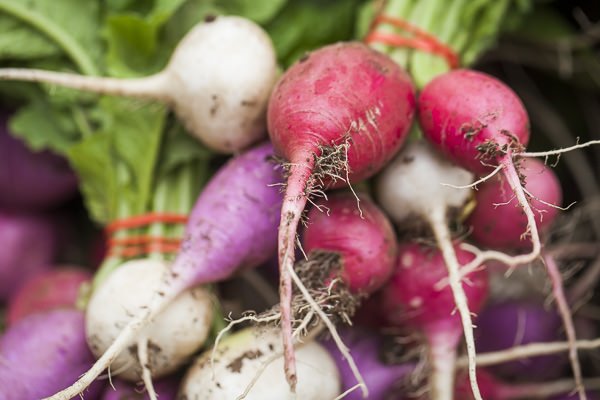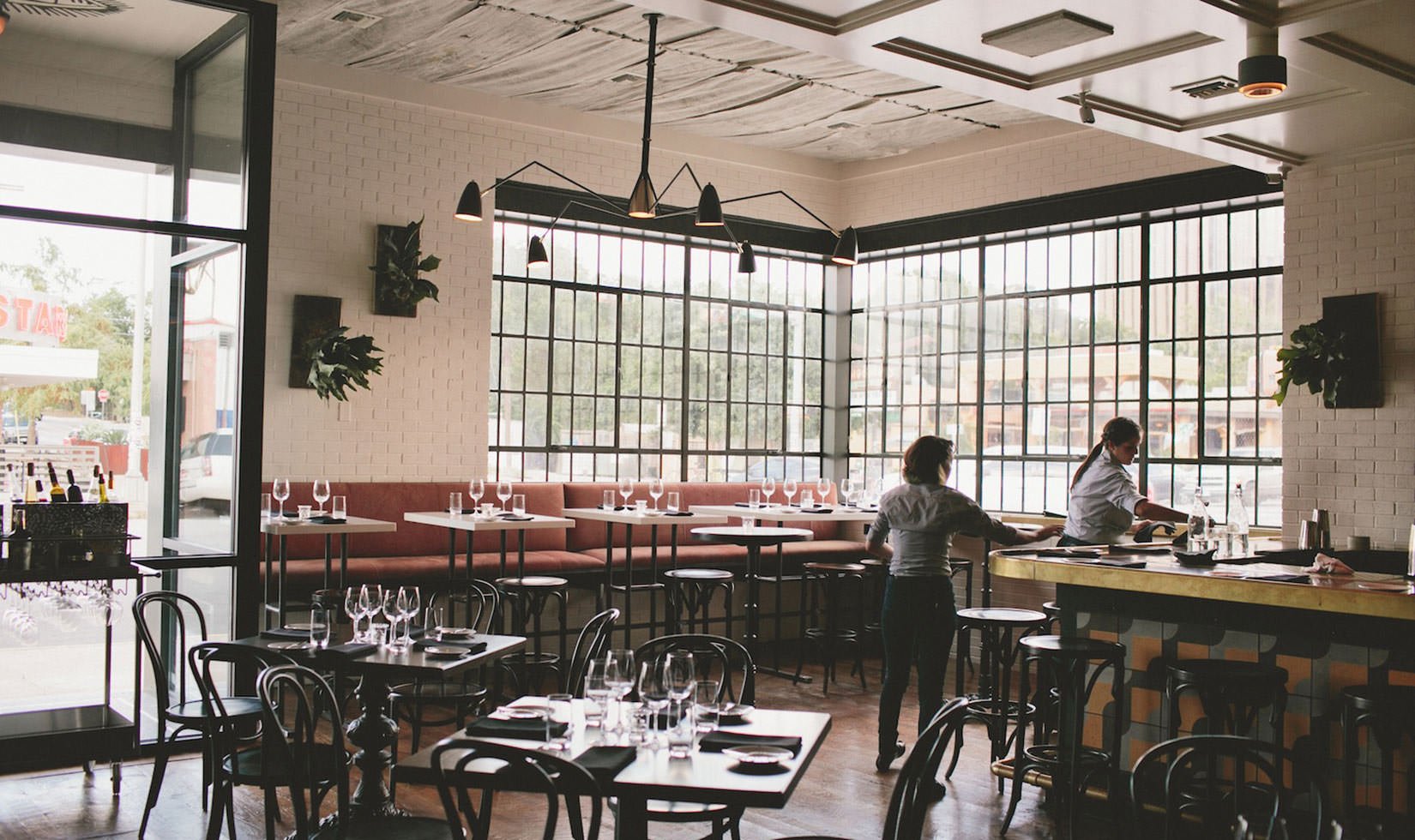Plenty of Texans have vowed to keep Austin weird. Now a handful of chefs, farmers and sommeliers are working together to make their capital’s food scene local, seasonal, and in true Austin form, eclectic.
In this edition of our regional spotlight series, we take a look at the top restaurant trends in one of the nation’s most progressive cities.
The rise of both urban and regional farms and their impact on restaurants.

The success of these urban farms has not been without controversy in Austin, where demand for hotels rooms and housing has exceeded supply for years, but the sustainable food movement is strong and spreading throughout Central Texas.
“In addition to Austin’s thriving urban farms, area farmers markets have expanded exponentially over the past year to allow chefs access to local food from hundreds of organic and sustainable farms and producers within a 100-mile radius of Austin—six days a week,” said Marla Camp, publisher of Edible Austin, a bi-monthly publication celebrating local food and food culture in Central Texas, season by season.
Edible Austin curates a map of the entire region’s farmers’ markets and stands available to chefs and consumers, as well as a map of more than 100 area restaurants that source at least 50 percent of their ingredients locally.
“Ultimately, local food grown by people who care tastes better, is more seasonal and has a smaller carbon footprint than big brand products,” says Steven Allen Ridge, Director of Operations for McGuire Moorman Hospitality, which owns and operates a handful of restaurants in the Austin area, including Elizabeth Street Café, Perla’s, and Jeffery’s and Josephine House, the latter two neighboring restaurants named one of Bon Appetit’s Top 50 New Restaurants in 2013.
Having hundreds of farms located anywhere from a short bike ride to 100 miles from the restaurants is allowing chefs to take the concept of local, fresh and seasonal to new heights.
“Farmers and chefs are having daily conversations about what is being harvested,” says Craig Collins, Master Sommelier and Beverage Director for the ELM Restaurant Group, which was founded in 2009 by Chef Andrew Curren & Partners and owns Arro, 24 Diner, Easy Tiger and will open two additional concepts by 2015, one focusing on American classics and another Italian. “Every menu in the restaurant is changing as a result.”
The menu at 24 Diner recently featured an Heirloom Tomato and Pea Tendril Salad with Shaved Spring Onions, Watermelon Radishes and a Mint Vinaigrette, which was sourced from three different regional farms (Bella Verdi, Oak Hill and Hairston Creek) and one in West Texas. For Arro’s (pictured left) Smoked Trout Salad with Arugula, Fennel, Endive, English Cucumbers and Lemon Dill Vinaigrette, the cucumbers traveled from West Texas, but the fennel and dill came from Johnson’s Backyard Garden (pictured below) a few miles from the kitchen.
“Sourcing the ultimate local products is a full-time, ever-changing job,” says Andrew Curren, Executive Chef and partner at ELM, whose three restaurants source from more than 80 farms. While Texas’s Farm to Table helps with the logistical coordination, it’s up to Curren and his sous chef to constantly source new farms, new local ingredients and new local purveyors.
 The challenges of farm-fresh sourcing go beyond logistical. It’s quite difficult to grow food and raise animals in Central Texas due to the extremes in temperatures. A late spring freeze can wipe out an entire crop—which happened to artichokes this year and strawberries last year. Growing seasons are typically very short and often vulnerable, and Austin is also faced with the lack of reliable water sources, even when the city is not experiencing extreme drought patterns like it has for the past several years. “It is laudable that farmers and chefs who have a commitment to sourcing local food are becoming nimble at adapting their menus to these challenges,” Camp says.
The challenges of farm-fresh sourcing go beyond logistical. It’s quite difficult to grow food and raise animals in Central Texas due to the extremes in temperatures. A late spring freeze can wipe out an entire crop—which happened to artichokes this year and strawberries last year. Growing seasons are typically very short and often vulnerable, and Austin is also faced with the lack of reliable water sources, even when the city is not experiencing extreme drought patterns like it has for the past several years. “It is laudable that farmers and chefs who have a commitment to sourcing local food are becoming nimble at adapting their menus to these challenges,” Camp says.
These relationships between grower and cook are becoming the central force behind each restaurant concept. “We have more options of product, service and delivery than we’ve ever had,” Ridge says. “Farms in Austin continue to grow and increase the quality of their business, which makes using local products much more practical for busy restaurants like ours.” As the food community grows stronger, so does the local economy.
Daily wine features are being added to complement those fresh ingredients; Collins has created a clever program at Arro called “Wine of the Moment,” where the wine changes daily to match new dishes or even a change in the weather. One night in March, Collins and the chef paired the grilled quail from Texas Quail Farms in Lockhart, Texas, with a 2011 Domaine les Gran Bois “Cuvee Philippine” Cotes du Rhone. The sustainably raised quail was served with a cauliflower purée from Verstuyft Farm, pistachios, pea tendrils from Bluebonnet Farm and grapefruit from G&S Orchard near the Texas-Mexico border. He also might select a rustic red to feature on a rainy night then switch it out for Muscadet when the sunshine returns the following day. Gone are the days of a “one-size-fits-all” wine list.
Craft cocktails are constantly being invented, with inspiration coming from local herbs, fruits and even Texas-made liquors, such as whiskeys from Balcones Distillery, Tito’s Handmade Vodka, rum, gin, vodka or bourbon from Treaty Oak Distilling, bourbon from Garrison Brothers Distillery or orange and lemon liqueurs from Paula’s Texas Spirits. “Strawberries from local farms are driving the cocktail recipes in town this spring,” Collins says.
“Austin, as a whole, is pretty special place,” Collins says. “It’s a community that wants to support local, and food and wine is really a part of this city’s lifestyle.”
Chef-owned restaurant groups.
Savvy chefs are branching out and opening different restaurant concepts throughout the city. (A similar trend has been happening in the Northeast U.S. as well.) These chefs know the Austin consumer well—young, educated and adventurous—and are capitalizing on the opportunity to bring customers an array of distinct restaurant concepts.
“Chef-owned restaurants are just more nimble than big chains; we create the trends that big companies follow years later,” Ridge says. “Food should have soul and without an owner or chef who is personally invested in the business, it’s easy to feel a void.”
 Ridge has worked for McGuire Moorman Hospitality for five years and has assisted chef-restaurateur Larry McGuire expand from one restaurant to five during his tenure. “We are passionate about the hospitality aspect of our business, we love being at our restaurants and interacting with our staff and customers. We are young, ambitious, love what we are doing and we love Austin. We want to continue to help make Austin a premiere place to live and dine.”
Ridge has worked for McGuire Moorman Hospitality for five years and has assisted chef-restaurateur Larry McGuire expand from one restaurant to five during his tenure. “We are passionate about the hospitality aspect of our business, we love being at our restaurants and interacting with our staff and customers. We are young, ambitious, love what we are doing and we love Austin. We want to continue to help make Austin a premiere place to live and dine.”
These local groups are creating very focused concepts, such as ELM’s24 Diner, a 24-hour urban diner offering chef-driven comfort food, local and organic fare, a full bar and an intriguing wine list, all at affordable prices, or McGuire Moorman’s Perla’s, an oyster bar and seafood restaurant with a spacious, beach-style patio (pictured above right). Father-son chefs Jack Gilmore and Bryce Gilmore, both fixtures at the farmer’s markets in Austin, operate Jack Allen’s Kitchen, Barley Swine and Odd Duck, and chef-owner Sonya Cote’s restaurant, Eden East, is actually located right on Springdale Farm; she also opened another local-sourcing eatery and grocery inside an old drugstore called Hillside Farmacy. These are just a few of the chef-owned restaurant groups creating a diversity of experiences for the locals in a city notorious for nightlife and dining out.
“The thing I notice about Austin is you can’t have a preconceived notion about what the restaurant will look like or where it will be located,” says Brad Butcher, Central Regional Sales Director for Jordan. “Some of the best places seem to be located in what looks like someone’s bungalow house or a muffler shop. You can’t judge the place by what it looks like on Yelp either. It’s part of the romance of Austin and what keeps it weird.”
Adventurous palates hungry for more.
Consumers are getting even more adventurous with wine choices in Austin. Sure, they’ll still be able to find a cold beer every 20 feet along the 6th Street bar strip, but they’ll just as easily discover an orange wine by the glass at many of the hottest restaurants. Sparkling wines are fast becoming a favorite, too. “Champagne and other bubblies are being consumed much more frequently now,” Collins says. “They’re becoming an everyday drink. That’s a huge shift from 10 years ago in Austin.”
Creature comforts just don’t seem to fit with Austin hip. “We are very fortunate as sommeliers to have curious customers who want to try things they’ve never heard of,” Collins (pictured below) says. “Unusual French varieties such as Picpoul or Poulsard and Italian wines such as Greco di Tufo and Nerello Mascalese are very interesting to our customers.” These customers want to be “put in the hands” of the sommelier and explore new wines more so now than ever before. “Part of what I love about my job is the diversity. Each ELM concept is different, and it allows me to design educational, yet approachable wine programs around different cuisines that excite our clientele,” Collins says.
This enthusiasm to experiment starts with the local wine community. Austin has a very educated sommelier/wine buyer base. In addition to the city’s two Master Sommeliers, there are more than a dozen men and women studying for their advanced exams with The Court of Master Sommeliers, and these leaders are driving the wine discovery for their customers. “Sommeliers are always working the floor and saying things like, ‘I found this Sauvignon Blanc, 2010 Clotilde Davenne Saint-Bris from Saint Bris in Northern Burgundy, which has a really lovely acidity and citrus note, and I’m excited to share this with you,’” Collins says.
“I have noticed an increase in classic grapes, such as Gamay, Muscat, Grenache and Cabernet Franc on wine lists in Austin,” Butcher says. “Old-world grapes made in styles that are approachable, fruit-forward and acid-driven style that is very food friendly, which pairs nicely with how progressive chefs are in the city.”
Wine distribution evolving with the market.
Has this shift in wine interests changed the wine distributor landscape?
Absolutely.
Large distributors, such as Glazer’s and Republic National Distributing Company which represent the majority of the wines sold, have adapted to the desire for small-lot, unusual wines and are changing their approach to selling. “They realize you can’t talk to the buyer of a small, independent restaurant group the same way they call on big chains or liquor stores,” Collins says.
 The mentality of the wine buyers had to shift as well. “ELM used to deal with the three large distributors,” Collins says. “Now we deal with fourteen.” Wine buyers used to enjoy the convenience of only having a few distributor reps calling on them and vice versa, but the diversification of the wine market demands juggling sometimes a dozen distributor sources. While this practice has been embraced by San Francisco and New York sommeliers for more than a decade, it’s only recently gained momentum in the center of the country, especially in Austin.
The mentality of the wine buyers had to shift as well. “ELM used to deal with the three large distributors,” Collins says. “Now we deal with fourteen.” Wine buyers used to enjoy the convenience of only having a few distributor reps calling on them and vice versa, but the diversification of the wine market demands juggling sometimes a dozen distributor sources. While this practice has been embraced by San Francisco and New York sommeliers for more than a decade, it’s only recently gained momentum in the center of the country, especially in Austin.
“Distributors big and small want to be a part of our eclectic programs and want to help me move these concepts forward,” Collins says. “I couldn’t do my job without all these different partners.”
About five years ago, while many economies around the country were tanking and Austin’s tech, film and music scenes were thriving, entrepreneurial wine salesmen saw the need to offer more atypical wines from smaller international producers. A new crop of boutique wine distributors was born, with names such as Rootstock, Serendipity and Lerin Wines. Their growing importance in the Austin market has come to the forefront in the last two years.
“We have so many small distributors that are focused on quality and customer service,” Collins says. “We’ve also seen quite a few new distributors open that are hyper focused on countries and even regions. I’m working with a new company that only distributes Spanish wines and another one that only offers small French producers.” These tiny distributors are very focused on niche products just like the niche restaurant concepts they are targeting for business relationships. Specializing within the wine sales space, according to Collins, helps these newcomers position themselves as experts and gain credibility with the local sommelier community.
Shift in how people eat.
While the snackification of dining continues to drive San Francisco’s restaurant scene, the small plates movement isn’t as big in Austin.
“I think a lot of consumers are now looking for a different experience when they go out. It’s not so much about trying lots of different plates over the course of a meal,” Collins says. Guests who visit ELM restaurants sometimes just want a cocktail and an appetizer. Other times, they just want dessert and after-dinner drink. Of course, diners still patron restaurants to enjoy an entire meal, but their numbers have decreased.
“The most successful restaurants are those that can deliver all those different experiences. It’s more about giving customers several styles of restaurants to choose from, accommodating guests and tailoring experiences to suit their mood,” Collins says. We are now working in a world where the philosophy has to be, ‘We can do whatever you want to do, and we’ll make it special for you.’”
 People are always going to be interested in the next trend but are also still grounded in classic food and friendly service, according to Ridge. “In recent years, our guests have become more knowledgeable from their repeated experiences, food media coverage, and access to great products via stores like Whole Foods and Central Market. Restaurants have to provide a whole experience that is fun and exciting to diners. I think the general consumer also has more wine knowledge now and can be introduced more easily to things outside their comfort zones.”
People are always going to be interested in the next trend but are also still grounded in classic food and friendly service, according to Ridge. “In recent years, our guests have become more knowledgeable from their repeated experiences, food media coverage, and access to great products via stores like Whole Foods and Central Market. Restaurants have to provide a whole experience that is fun and exciting to diners. I think the general consumer also has more wine knowledge now and can be introduced more easily to things outside their comfort zones.”
Will Austin’s younger demographic grow more fond of multi-course meals at one restaurant as they get older? That’s the question wine marketers are asking themselves.



